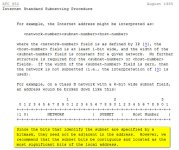Alan Case
Lifetime Supporting Member
Hi.
My understanding of a class C address for example 192.168.210.10 was that it could only communicate with devices on the 192.168.210.X range when a subnet mask of 255.255.255.0 was used. Changing the 3rd octet of the mask did not allow a 192.168.210.x device to talk to a device on the 192.168.211.x network.
A class B network device ie 172.16.x.x device could talk to all approx 65k devices on these 2 networks if you use a 255.255.0 subnet.
Now I am being told that there is classless addressing and you can manipulate the subnet on a class C to allow a 192.168.210.x device to talk to a 192.168.211.x device.
The above relates to PLC, drive, remote io etc devices.
Regards Alan Case
My understanding of a class C address for example 192.168.210.10 was that it could only communicate with devices on the 192.168.210.X range when a subnet mask of 255.255.255.0 was used. Changing the 3rd octet of the mask did not allow a 192.168.210.x device to talk to a device on the 192.168.211.x network.
A class B network device ie 172.16.x.x device could talk to all approx 65k devices on these 2 networks if you use a 255.255.0 subnet.
Now I am being told that there is classless addressing and you can manipulate the subnet on a class C to allow a 192.168.210.x device to talk to a 192.168.211.x device.
The above relates to PLC, drive, remote io etc devices.
Regards Alan Case







